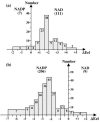Rational proteomics II: electrostatic nature of cofactor preference in the short-chain oxidoreductase (SCOR) enzyme family
- PMID: 15340916
- PMCID: PMC1476702
- DOI: 10.1002/prot.20205
Rational proteomics II: electrostatic nature of cofactor preference in the short-chain oxidoreductase (SCOR) enzyme family
Abstract
The dominant role of long-range electrostatic interatomic interactions in nicotinamide adenine dinucleotide/nicotinamide adenine dinucleotide phosphate (NAD/NADP) cofactor recognition has been shown for enzymes of the short-chain oxidoreductase (SCOR) family. An estimation of cofactor preference based only on the contribution of the electrostatic energy term to the total energy of enzyme-cofactor interaction has been tested for approximately 40 known three-dimensional (3D) crystal complexes and approximately 330 SCOR enzymes, with cofactor preference predicted by the presence of Asp or Arg recognition residues at specific 3D positions in the beta2alpha3 loop (Duax et al., Proteins 2003;53:931-943). The results obtained were found to be consistent with approximately 90% reliable cofactor assignments for those subsets. The procedure was then applied to approximately 170 SCOR enzymes with completely uncertain NAD/NADP dependence, due to the lack of Asp and Arg marker residues. The proposed 3D electrostatic approach for cofactor assignment ("3D_DeltaE(el)") has been implemented in an automatic screening procedure, and together with the use of marker residues proposed earlier (Duax et al., Proteins 2003;53:931-943), increases the level of reliable predictions for the putative SCORs from approximately 70% to approximately 90%. It is expected to be applicable for any NAD/NADP-dependent enzyme subset having at least 25-30% sequence identity, with at least one enzyme of known 3D crystal structure.
Copyright 2004 Wiley-Liss, Inc.
Figures


Similar articles
-
Rational proteomics I. Fingerprint identification and cofactor specificity in the short-chain oxidoreductase (SCOR) enzyme family.Proteins. 2003 Dec 1;53(4):931-43. doi: 10.1002/prot.10512. Proteins. 2003. PMID: 14635134
-
The crystal structure of d-glyceraldehyde-3-phosphate dehydrogenase from the hyperthermophilic archaeon Methanothermus fervidus in the presence of NADP(+) at 2.1 A resolution.J Mol Biol. 2000 Mar 24;297(2):481-500. doi: 10.1006/jmbi.2000.3565. J Mol Biol. 2000. PMID: 10715215
-
Crystal structure of a biliverdin IXalpha reductase enzyme-cofactor complex.J Mol Biol. 2002 Jun 21;319(5):1199-210. doi: 10.1016/S0022-2836(02)00383-2. J Mol Biol. 2002. PMID: 12079357
-
NAD-binding domains of dehydrogenases.Curr Opin Struct Biol. 1995 Dec;5(6):775-83. doi: 10.1016/0959-440x(95)80010-7. Curr Opin Struct Biol. 1995. PMID: 8749365 Review.
-
The shikimate dehydrogenase family: functional diversity within a conserved structural and mechanistic framework.Arch Biochem Biophys. 2015 Jan 15;566:85-99. doi: 10.1016/j.abb.2014.12.006. Epub 2014 Dec 15. Arch Biochem Biophys. 2015. PMID: 25524738 Review.
Cited by
-
Rational proteomics V: structure-based mutagenesis has revealed key residues responsible for substrate recognition and catalysis by the dehydrogenase and isomerase activities in human 3beta-hydroxysteroid dehydrogenase/isomerase type 1.J Steroid Biochem Mol Biol. 2006 Sep;101(1):50-60. doi: 10.1016/j.jsbmb.2006.06.004. Epub 2006 Aug 4. J Steroid Biochem Mol Biol. 2006. PMID: 16889958 Free PMC article.
-
Characterization of NADP+-specific L-rhamnose dehydrogenase from the thermoacidophilic Archaeon Thermoplasma acidophilum.Extremophiles. 2012 May;16(3):447-54. doi: 10.1007/s00792-012-0444-1. Epub 2012 Apr 6. Extremophiles. 2012. PMID: 22481639
-
Determinants of Cofactor Specificity for the Glucose-6-Phosphate Dehydrogenase from Escherichia coli: Simulation, Kinetics and Evolutionary Studies.PLoS One. 2016 Mar 24;11(3):e0152403. doi: 10.1371/journal.pone.0152403. eCollection 2016. PLoS One. 2016. PMID: 27010804 Free PMC article.
-
L-Rhamnose Dehydrogenase LraA of Aspergillus niger Shows High Substrate Specificity Matching Its Expression Profile.J Fungi (Basel). 2025 Apr 10;11(4):301. doi: 10.3390/jof11040301. J Fungi (Basel). 2025. PMID: 40278122 Free PMC article.
-
Biochemical factors governing the steady-state estrone/estradiol ratios catalyzed by human 17beta-hydroxysteroid dehydrogenases types 1 and 2 in HEK-293 cells.Endocrinology. 2009 Sep;150(9):4154-62. doi: 10.1210/en.2008-1817. Epub 2009 Jun 25. Endocrinology. 2009. PMID: 19556422 Free PMC article.
References
-
- Duax WL, Pletnev V, Addlagatta A, Bruenn J, Weeks CM. Rational proteomics I. Predicting fold and cofactor preference in the short-chain oxidoreductase (SCOR) enzyme family. Proteins. 2003;53:931–943. - PubMed
-
- Jörnvall H, Höög JO, Persson B. SDR and MDR: completed genome sequences show these protein families to be large, of old origin, and of complex nature. FEBS Letters. 1999;445:261–264. - PubMed
-
- Sander C, Schneider R. Database of homology-derived protein structures and the structural meaning of sequence alignment. Proteins. 1991;9:56–68. - PubMed
Publication types
MeSH terms
Substances
Grants and funding
LinkOut - more resources
Full Text Sources

